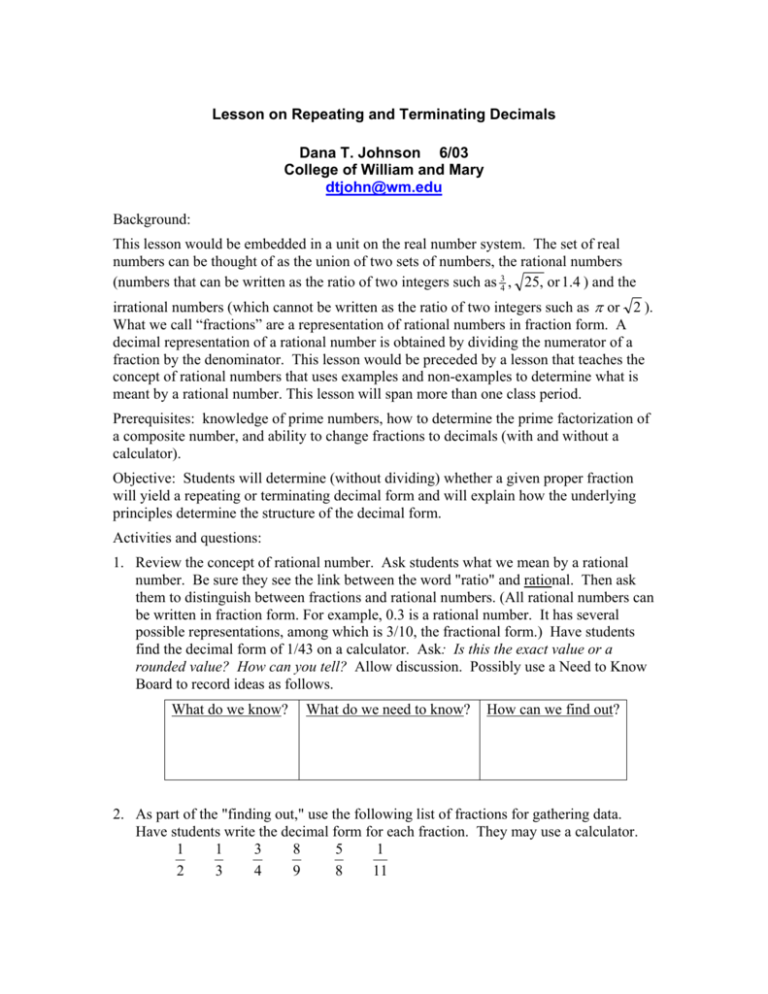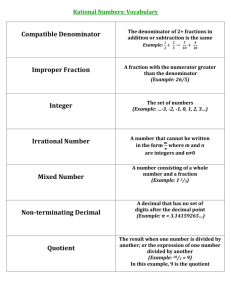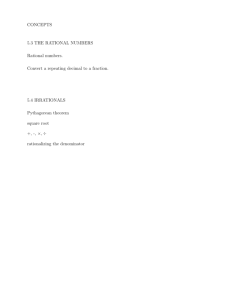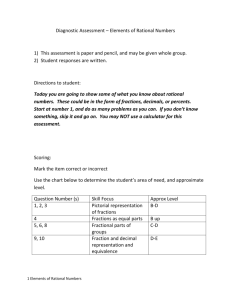Lesson on Repeating and Terminating Decimals
advertisement

Lesson on Repeating and Terminating Decimals
Dana T. Johnson 6/03
College of William and Mary
dtjohn@wm.edu
Background:
This lesson would be embedded in a unit on the real number system. The set of real
numbers can be thought of as the union of two sets of numbers, the rational numbers
(numbers that can be written as the ratio of two integers such as 34 , 25, or 1.4 ) and the
irrational numbers (which cannot be written as the ratio of two integers such as π or 2 ).
What we call “fractions” are a representation of rational numbers in fraction form. A
decimal representation of a rational number is obtained by dividing the numerator of a
fraction by the denominator. This lesson would be preceded by a lesson that teaches the
concept of rational numbers that uses examples and non-examples to determine what is
meant by a rational number. This lesson will span more than one class period.
Prerequisites: knowledge of prime numbers, how to determine the prime factorization of
a composite number, and ability to change fractions to decimals (with and without a
calculator).
Objective: Students will determine (without dividing) whether a given proper fraction
will yield a repeating or terminating decimal form and will explain how the underlying
principles determine the structure of the decimal form.
Activities and questions:
1. Review the concept of rational number. Ask students what we mean by a rational
number. Be sure they see the link between the word "ratio" and rational. Then ask
them to distinguish between fractions and rational numbers. (All rational numbers can
be written in fraction form. For example, 0.3 is a rational number. It has several
possible representations, among which is 3/10, the fractional form.) Have students
find the decimal form of 1/43 on a calculator. Ask: Is this the exact value or a
rounded value? How can you tell? Allow discussion. Possibly use a Need to Know
Board to record ideas as follows.
What do we know?
What do we need to know?
How can we find out?
2. As part of the "finding out," use the following list of fractions for gathering data.
Have students write the decimal form for each fraction. They may use a calculator.
1
1
3
8
5
1
9
8
11
2
3
4
3 Make a two-column table on the board and separate the fractions from (2) into two
lists
Fractions that convert to
repeating decimals
4.
Fractions that convert to
terminating decimals
Use the following question as the basis of a discuss about the nature of fractions: If
we choose any fraction, divide the numerator by the denominator to generate a
decimal form, will the resulting decimal form always fall into one of the two
categories above? or is could the decimal form be a non-repeating, non-terminating
decimal? Why?
(The answer is that all fractions will convert to either a repeating or terminating
form. If students are having trouble, have them examine the process of long division
used in changing from fraction form to decimal form. They should see that
eventually they will run out of different possibilities for remainders so either the
remainder will be zero or they will re-encounter the original dividend, thus revisiting
the previous cycle of divisors.)
5. Ask students to go back to the table and study the entries. In small groups they
should see if they can form a conjecture that will predict which category a given
fraction belongs to. Have them write up their findings but they will not share them
yet.
6. Call the attention of all groups to the list of fractions below. Ask them to use their
conjectures to assign these fractions to the table (no actual division should be allowed
until after they have made a decision. Then they can check on the calculator).
199
5
9
15
11
6
17
7
125
200
13
80
24
24
If they were not right, they can revise the conjecture, choose some more fractions to
guess and check. (Note: You may suspect that a group has discovered the rule if they
are consistently placing fractions in the right group. Do not let them give away the
rule to other students if they have discovered it.)
7. If the students are having trouble, prompt their thinking with questions such as these;
a) Does the outcome depend on the numerator? How can you find out? (Gently
nudge them, but do not tell them directly. Write out the list of simplified fractions
with the same denominator but different numerators and study their placement in
the two groups. Do another list using another common denominator. This
incorporates elements of good experimental design—holding one variable
constant (the denominator) and repeated trials.)
b) Does it depend on the denominator? How can you find out? (You can use a
similar method as in part (a)).
Teacher Background:
A fraction (in simplest form/lowest terms) terminates in its decimal form if the prime
factors of the denominator are only 2’s and 5’s or a combination of 2’s and 5’s.
Otherwise it repeats. In the examples listed below, factor the denominators into
prime factors and see what you get!
½ = 0.5
4/5 = 0.8
3/10 = 0.3
4/25 = 0.16
3/16 = 0.1875
7/20 = 0.35
1 / 3 = 0.3
1 / 15 = 0.06
7 / 30 = 0.23
3 / 7 = 0.428571
9 / 22 = 0.409
5 / 13 = 0.384615
8. Have each group report on their findings and through discussion make sure all have
discovered the rule. Then ask about 3/12. It is a terminating decimal—but the prime
factorization of the denominator is 2 × 2 × 3 , so shouldn’t it repeat? Encourage
discussion.
(Answer: 3/12 is not in lowest terms. The rule only applies to fractions that are
completely simplified.)
9. Have students write in their math journals using a prompt such as this: "Explain why
the decimal form of 3/11 is repeating and the decimal form of 3/40 terminates."
10. Lead a whole class discussion using questions such as the following:
• Is our reasoning in this problem an example of inductive or deductive reasoning?
Why?
• How do we know this “rule” that we have conjectured is always true?
• Is it sufficient to show it works for 10 examples? 100? 1000? (inductive reasoning)
• What can you see about the structure of our number system that makes this work?
(Answer: Ours is a decimal system! This means that each digit represents a group of
some power of ten. Since 10 = 2 × 5 , you can convert each fraction whose
denominator contains only factors of 2’s and 5’s into an equivalent fraction whose
denominator is some power of ten. When the denominator is a power of ten, the
decimal form terminates. Ex: 4/25 = 16/100=0.16. This is deductive reasoning as
we are reasoning from known facts and relationships and applying them to this
particular situation.)
Assessment:
Ask students to the following to be written in their math journals:
1) Which of the following fractions terminate in their decimal form?
3
4
7
7
1
9
7
55
3
1
8
15
9
50
40
36
99
56
20 14
Write a short paragraph telling how you made those decisions.
2) Explain the underlying principles of our number system that make these
"fraction to decimal patterns" work.
Homework:
Design a pre-test which consists of 10 fractions on a page. Ask an adult (family member,
neighbor, your English teacher, etc.) to circle the fractions that they think will terminate
in their decimal form. (Do not let them actually divide.) If they do not get them right,
teach them how to do it using what you have learned about the patterns of rational
numbers. Then give them a post-test to see if your teaching was effective. Be prepared
to report about your experience to the class. (The debriefing of this assignment may
include discussion about how well known this pattern is among adults.)
Application:
Why do we care about this characteristic of fractions?
a) We use calculators so much that we are used to the decimal display of most
numbers we sue. Try dividing 1 by 23 on the calculator. The display probably
reads 0.0434782. You are a smart person… now you know more than the
calculator is telling you. Is the displayed value exact?
b) Until recently stock prices on the New York Stock Exchange (NYSE) were given
in rational form, rounding prices to the nearest eighth of a dollar. Now the prices
are given in decimal form. What are the advantages and disadvantages of each
system of reporting and bookkeeping?
c) Fabric is measured to the nearest 1/8 of a yard in fabric store. Why do you think
eighths are the fraction of choice?
Extension:
1. Think about the following question: "What is the maximum number of decimal places
necessary before the decimal representation of a fraction will either repeat or
terminate?"
• Make a plan for finding out.
• Carry out the plan.
• Use your hypothesis to predict the number of places required in the cycle of
repeating digits in the decimal expansion of 1/47.
• Write a description of what you decided and how you found out.
• Discuss with the whole class and see if all reached the same conclusion. If you
did not, argue for your point of view or acknowledge that your result was flawed.
Assessment for this extension:
Assume that you are Dr. Math at the Math Forum (http://forum.swarthmore.edu) and a
student sends you the question below. Write a response to the student in your math
journal.
"Dear Dr. Math,
A section about rational and irrational numbers in our algebra textbook has the
following question: A student who used long division to find the repeating
decimal form for 171 claimed that there were 20 digits in the repeating block of
digits. Is this correct? Explain.
The textbook answer says that there can be no more than 16 digits in the repeating
block. Do you have to divide it out to figure this out, or can you predict the
number of digits without dividing?
Thanks,
A Lost Student"
2. Let R represent a rational number that has a repeating decimal expansion. Let T
represent a rational number that has a terminating decimal expansion.
a) What can you say about the nature of R+T? Can you prove it?
b) What can you say about the nature of R/T? Can you prove it?
c) What can you say about the nature of T/R? Can you prove it?
The concept of CLOSURE means that when 2 elements of a set interact under a given
operation, the result is a member of the original set. For example, the set of even integers
is closed under the operation of addition because when you add two even integers , the
result is an even integer. But the set of positive integers is not closed under subtraction
because sometimes when you subtract two positive integers, you get a result that is not a
positive integer (3 - 5 = -2).
Is the set of {R} closed under addition? How do you know?
Is the set of {T} closed under addition? How do you know?
3. The Pythagoras was an ancient Greek mathematician who was born in 572 BC. His
followers thought that any magnitude could be expressed as a rational number. When
they discovered this was not true, they were deeply upset. Read more about this
discovery and report to the class.





